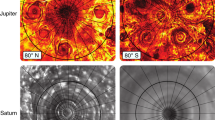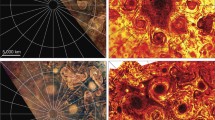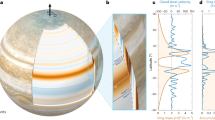Abstract
On July 5, 2016, NASA’s Juno station began flying around Jupiter in a meridional orbit, having detected eight cyclones near the poles in latitude ±82° near the North Pole (NP) and five somewhat larger cyclones near the South Pole (SP). Both of these publications say that the origin of these cyclones is unknown. However, in the late 1960s, it was found that the four largest planets have an internal heat source, although that of Uranus is relatively weaker than the rest, for it is comparable to the heat flux from the Sun at their distances. The theory of convection of rotating fluids makes it possible, using additional arguments, to obtain estimates of diameters and velocities in cyclones that are comparable with the observed ones.

Similar content being viewed by others
REFERENCES
A. Adriani, A. Mura, G. Orton, et al., “Clusters of cyclones encircling Jupiter’s poles,” Nature 555, 216–219 (2018).
F. Tabataba-Vakili, J. H. Rogers, G. Eichstädt, et al., “Long-term tracking of circumpolar cyclones on Jupiter from polar observations with JunoCam,” Icarus 335, 113405 (2020).
A. N. Kolmogorov, “Zufällige Bewegungen,” Ann. Math 35, 116–117 (1934).
E. B. Gledzer and G. S. Golitsyn, “Scaling and finite ensembles of particles in motion with the energy influx,” Dokl. Phys. 55 (8), 369–373 (2010).
G. S. Golitsyn, “Laws of random walks derived by A. N. Kolmogorov in 1934,” Russ. Meteorol. Hydrol. 43 (3), 135–142 (2018).
G. S. Golitsyn, “Polar lows and tropical hurricanes: Their energy and sizes and a quantitative criterion for their generation,” Izv., Atmos. Ocean. Phys. 44 (5), 537–547 (2008).
A. P. Ingersoll, S. P. Ewald, F. Tosi, et al., “Polygonal patterns of cyclones on Jupiter: Convective forcing and anticyclonic shielding,” Proc. Natl. Acad. Sci. (2021) [in press].
G. S. Golitsyn, “A similarity approach for the general circulation of planetary atmospheres,” Icarus 13 (1), 1–24 (1970).
B. M. Boubnov and G. S. Golitsyn, Convection in Rotating Fluids (Kluwer, Dordrecht, 1995).
A. S. Monin and A. M. Yaglom, Statistical Hydromechanics, Vol. 2 (MIT Press, 1975; Nauka, Moscow, 1967).
G. S. Golitsyn, Probabilistic Structures of the Microworld: Earthquakes, Hurricanes, Floods… (Fizmatlit, Moscow, 2021) [in Russian].
A. M. Obukhov, “Turbulence in Lagrangian terms,” Adv. Geophys. 7, 115–117 (1959).
G. S. Golitsyn and L. A. Dikii, “Proper oscillations of planetary atmospheres depending on the rotation rates of planets,” Izv. Akad. Nauk SSSR, Fiz. Atmos. Okeana 2 (3), 225–233 (1966).
M. S. Longuet-Higgins, “The eigenfunctions of Laplace’s tidal equation over a sphere,” Philos. Trans. R. Soc. 262 (1132), 511–607 (1968).
L. A. Diky and G. S. Golitsyn, “Calculation of the Rossby wave velocities in the Earth’s atmosphere,” Tellus 20 (2), 314–317 (1968).
S. S. Hough, “On the application of harmonic analysis to the dynamical theory of the tides. Part II. On the general integration of Laplace’s dynamical equation,” Philos. Trans. R. Soc. 191, 139–185 (1898).
ACKNOWLEDGMENTS
I am deeply grateful to O.G. Chkhetiani for his attention to this topic, assistance in the work, and discussing its results, as well as to a reviewer whose comments and questions significantly improved the original text.
Author information
Authors and Affiliations
Corresponding author
Rights and permissions
About this article
Cite this article
Golitsyn, G.S. Simple Arguments for Jupiter’s Circumpolar Cyclones. Izv. Atmos. Ocean. Phys. 57, 547–550 (2021). https://doi.org/10.1134/S0001433821060050
Received:
Revised:
Accepted:
Published:
Issue Date:
DOI: https://doi.org/10.1134/S0001433821060050




